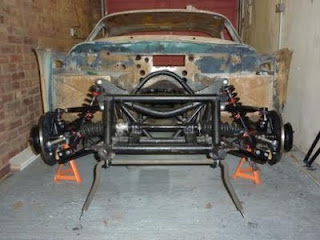I have been looking forward to getting the hubs on the car for weeks. Its another stage in the rebuild where you can look at the car and see real progress. At the monment I have the front wishbones on and the vertical links in place, but no hubs. Before the hubs go on, I have to clean up and paint the brake disc dust sheilds and this turned into a job of several weekends.
The dust shields that came with my box of bits were not in great shape. They were very rusty but looked like they might be "kind of servicable" once they had been cleaned up, so I treated them to a good soak in Deox - C. They cleaned up OK but even the better of the two looked a bit second hand, even when painted up. The worst one looked more like a doiley than a dust sheild once the "structural" rust was all gone. So, after a week spent cleaning them up and painting them, I admitted defeat and bought a couple of replacements.
The dust shields on my Vixen are in fact modified TR6 items (surprise!).
On the left, the better of my two original back plates, on the right a TR6 plate.
In the TR6 the small tab holds the back plate to the brake caliper mounting bracket, but in the Vixen, the the tab is not used. A
"new" bracket is positioned to locate under the nut holding the track rod end to the steering arm.
It appears that the factory ordered in the TR6 back plates, then drilled off the small tab (you can still see the remains of the spot welds), flattened it out, bent it and then brazed it back on to form a new tab. I had a go at mimicking the Blackpool approach, but the tabs ended up rather mangled, so I made up new ones and welded them on instead.
![]()
I've made them a little over-sized just in case. Lack of confidence in my measuring abilities!! I can cut them down to fit later if I need to.
So, now, I was finally ready to get the front hubs back on my Vixen. In the earlier posts you can see that I replaced one stub axle and one vertical link, but, I was never really happy with the condition of the second stub axle. It had been rusty and even once it was cleaned up, the machined surfaces were not great; so I decided to swap out the second stub axle too.
Then I started thinking about the second, original, vertical link. It maybe a little paranoid, but despite the fact that the trunion threads were in good condition, the link was probably 40 odd years old. This shouldn't really be an issue, but I had read somewhere that the vertical links are working at the limits of their design spec. in the Vixen. This niggled me, so, to be on the safe side, I decided to replace that as well. So I threw caution to the wind and ordered a new stub axle and new vertical link - being careful to order the correct side. Vixens use herald drum brake vertical links, but the sides are swaped, right link goes on the left side on the Vixen. So far, so good.
The vertical link came up beautifully having been painted, but heres where it started to go down hill. I had a set of new wheel bearings, and, having cleaned the surfaces, I fitted the new bearings into the hubs. Standing back to admire my handywork, I noticed that the race on one rear bearing had been ground badly off centre. So they had to come out again and go back. Without bearings the installation was put on hold for a week.
When the new ones turned up, they went in nicely and seemed fine. I was ready to slide the whole assembly over the sub axle, but damn me if now the hub won't go over the (brand new) stub axle. Its not just a tight fit, it wont go on no matter what. On closer examination it turns out the new stub axle has been incorrectly machined and the rear bearing is jamming up.
So, now lacking all faith in the quality of new parts, I ordered two used stub axles, thinking that, since these have already been fitted to a car, they ought to.... well.....fit.
So I rush off to the shed to trial fit the hubs...
Yep you guessed it, they don't fit.
So now I have 4 replacement stub axles of which 2 are too wide at the rear bearing, so the hubs wont push on, and two are too narrow so the axles push straight through withought touching the rear bearing at all. So, following a long phone call with the supplier, we finally alighted on two new axles that were in spec. and they duely arrived the next day.
So now I have the two hubs attached:
Unfortunately, in getting the hub on, I noticed that the rubber boots on both the (new) track rod ends have completely perished, to the point where they just crumbled when I moved them. So, more stuff to go back to the supplier. Annoying but I am really pleased to see the hubs in place finally.
Its starting to look like my goal of getting a rolling chassis by Christmas could be achievable. In order to finish the front end I now need shocks and springs (the old ones are far too far gone), brake calipers, track rod ends (!) and of course the anti roll bar, that I still haven't managed to source.
I am off to Silverstone this weekend, where I hear there will be classic TVRs racing. I will go and make a nuisence of myself in the paddock and see if anyone has any idea where I can get an ARB from.










































